
Whether you are intentionally breeding your cat, or, more commonly, are suddenly surprised that your cat is pregnant, you need to know what to expect when your cat is expecting.
In this article, we will be covering the basics of how cats give birth, the birthing process and the stages of labor, what to do when your cat is birthing, and how to care for mother and newborn kittens after birth.
How Cats Give Birth?
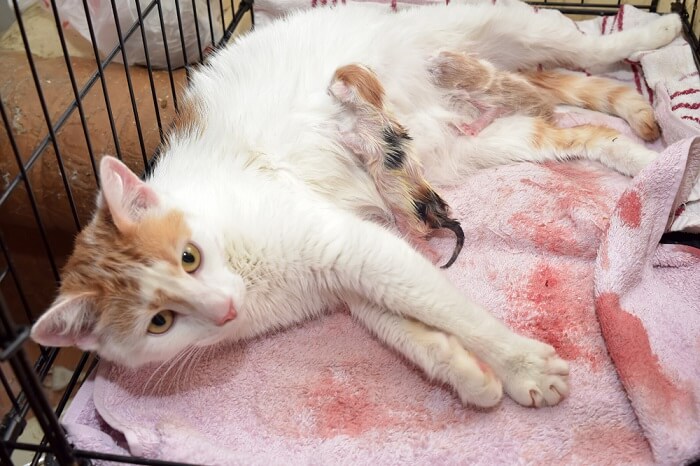
When cats give birth, it is called queening. The queening process looks very similar to birthing in humans.
When a cat gives birth, it is called queening. Most cats give birth to kittens in the same way that humans give birth: they deliver kittens including the placenta and the umbilical cord through the birth canal and out the vagina, and they nurse and care for their kittens after they are born.
Some cats, such as Persians or other flat faced breeds, are unable to deliver kittens naturally, and require a Cesarean section surgery to safely deliver kittens. This surgery is done under general anesthesia by a DVM.
Normal gestation (the length of a cat’s pregnancy) lasts 63-65 days. Mother cats typically know what to do when it is time to deliver, and if you find them building or sleeping in a cozy nest, then know you are in the final week of pregnancy, and it is almost time for the birthing process to begin.
Stages of Labor in Cats
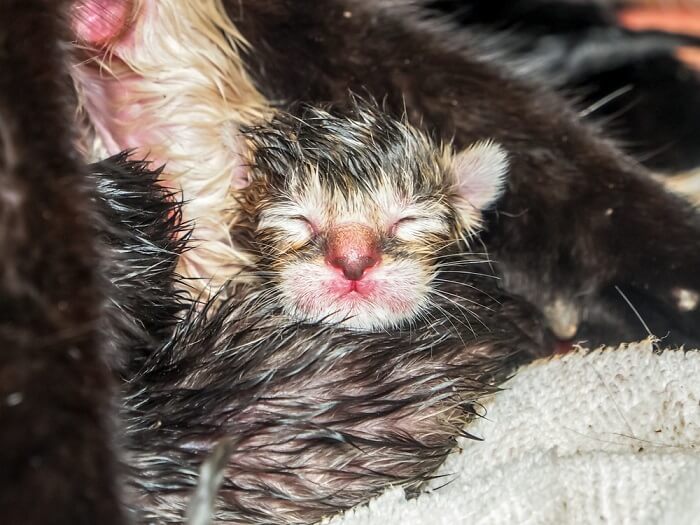
Cats go through several stages of labor, starting when the uterus starts to contract, the cervix relaxes, and the cat’s water breaks.
Just like humans, cats go through several stages of labor when they are about to give birth. The first stage of labor happens when the uterus, the hollow organ inside a cat’s belly where the kittens develop, starts contracting, the cervix starts to relax, and the cat’s water breaks.
Stage one lasts anywhere from 6-12 hours on average (up to 36 hours in first time mothers).
During stage one, a mother cat may meow more, or purr and be very social; it really depends on the cat.
The mother cat will usually refuse food starting 24 hours before giving birth, and her body temperature may drop under 100 degrees F. Pregnant cats in stage one rarely have discharge from their vulva.
Stage two labor happens when the kittens are delivered. It can take up to 16 hours on average for a cat to deliver all her kittens, some cats can take 3 days to finish delivery.
The length of stage two depends on how many kittens are present, whether this is a first pregnancy or not (first pregnancy deliveries tend to take longer), and if there are any difficulties with the birth. It will take longer for the first kitten to be born in first time mothers.
During stage two is when abdominal wall contractions and straining are noticed. These contractions help move the newborn kitten through the birth canal.
Delivery of a kitten after second stage labor starts usually takes 5 to 30 minutes. Once the head has passed the vulva, it usually two one or two abdominal contractions to deliver the rest of the kitten’s body. Once a kitten is delivered, the mother cat will remove the amniotic sac with her mouth, lick the kitten’s nose and mouth, and she will eat the umbilical cord and the placenta once it is delivered.
Stage three labor involves delivery of the afterbirth, which consists of the placenta and other fetal membranes. Stage three labor usually occurs in between delivery of each kitten, but sometimes, a kitten is delivered so quickly after another that stage three labor may temporarily delayed.
How long between kitten births varies, typically the interval can last 15 minutes to one hour. Sometimes labor seems interrupted. Interrupted labor happens when a mother cat stops straining, rests, nurses kittens already born, and may eat and groom, even if there are more kittens to deliver.
If a mother cat goes longer than one hour between giving birth to kittens, however, and you notice any of the following:
- straining without delivering
- she appears weak
- she is ignoring her already born kittens, then call your veterinarian for advice.
What To Do When Your Cat Is Giving Birth?
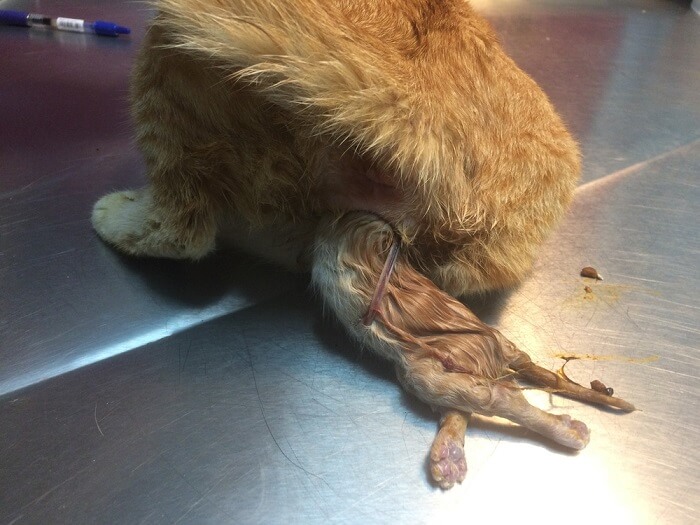
A difficult birth is referred to as dystocia and may involve intense straining, excessive bleeding, and more.
Most of the time, cat owners should not interfere with a mother cat that is delivering because in most cases, mother cats instinctually know what to do. Provide a quiet, warm, safe place to deliver, and check on her at least once an hour.
If you have a first time mother cat, however, then you should monitor her birthing process more closely, and watch for signs of dystocia, which means ‘difficult birth’.
Signs of dystocia can include:
- Intense abdominal straining to deliver for 20 minutes or longer without producing a kitten
- Intense straining for 10 minutes and failing to deliver a kitten that has already crowned (head is noticed at the vulva)
- Bleeding from the vulva for 10 minutes or longer
- The mother cat is lethargic, feverish (rectal temperature higher than 103 degrees F), or more than one hour has passed in between delivering kittens
Signs of dystocia indicate an emergency, and if any are noticed, call your local or emergency veterinarian immediately for advice. Otherwise, if everything proceeds normally, once all kittens have been born you can remove dirty bedding and replace it with clean bedding.
Caring for Mother and Kittens After Birth
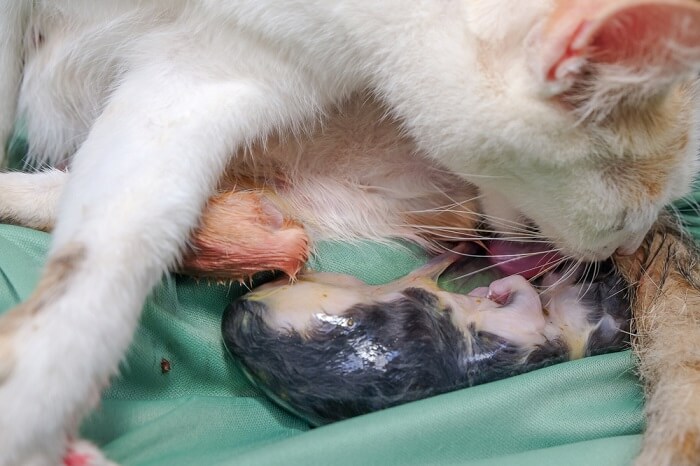
For the most part, cats are able to care for both themselves after birth. You will, however, want to regularly check on your new mother cat to ensure that everything is going well.
For most intents and purposes, healthy mother cats can take care of themselves. The only thing you need to do is check on her daily to make sure she is nursing her kittens, provide a safe, warm area for her to raise the kittens, watch for any signs of disease, and feed her an appropriate diet.
Mother cats expend a lot of energy making milk and recovering from delivery, so free-feed pregnant and nursing cats either a kitten formula cat food, or a cat food that is specifically formulated for pregnant or nursing cats.
Occasionally, mother cats can develop conditions related to pregnancy and nursing. Retained placenta, infection in the uterus, infected mammary gland, or eclampsia resulting from low calcium (milk fever) can all cause severe sickness in mother cats.
Signs that the mother cat needs veterinary attention include:
- poor appetite
- loss of energy
- refusing to nurse kittens
- feverish
- bloody vaginal discharge that doesn’t stop
- brown or foul smelling vaginal discharge
- sore abdomen
- vomiting
- panting
- muscle tremors or spasms
- inflamed nipple/mammary gland, may be hot, red, and have discharge (mastitis)
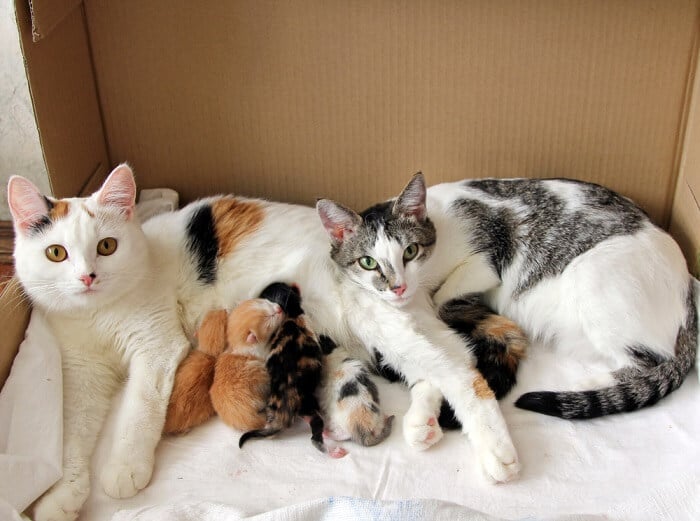
In addition to supervising your mother cat, you’ll want to keep an eye on the kittens to ensure that they’re healthy.
Newborn kittens need to stay warm and well fed. They cannot regulate their body temperature very well for the first weeks of life, so it is very important to provide a warm, dry, bed, nesting box, or cardboard box for kittens to live in.
Keep the temperature of the kitten’s area in between 85 and 90 degrees F during the first couple of days and then reduce the temperature to 80 degrees F after the first week. To maintain the higher temperature, you can use a or heating pad or a heat lamp, but hang the lamp high enough so it doesn’t get too hot, and provide space for the queen and kittens to move away from the heat source if they need to. When the kittens are one month old, start maintaining the temperature at 70 degrees F.
The nesting box should have sides that are tall enough to keep the kittens in for the first few weeks.
Provide mother cat with a litter box and food and water bowls that are in the same area as the nesting box.
If the mother cat isn’t nursing or is sick, then you will need to bottle feed the kittens. While there isn’t space in this article to go over all the logistics of bottle feeding, you can find everything you need to know about bottle feeding kittens here.
Otherwise, you can start the weaning process at 3-4 weeks of age. With a little knowledge, the birthing and kitten process can be a beautiful experience for all involved.
Frequently Asked Questions
What do I do when my cat's giving birth?
Most of the time, cat owners should not interfere with a mother cat that is delivering because in most cases, mother cats instinctually know what to do. Provide a quiet, warm, safe place to deliver, and check on her at least once an hour. If you have a first time mother cat, however, then you should monitor her birthing process more closely, and watch for signs of dystocia, which means 'difficult birth'.
If a mother cat goes longer than one hour between giving birth to kittens, or you notice her appearing weak or straining without delivering, or if she is ignoring her kittens that are already born, call your veterinarian.
What are the signs that your cat is in labor?
Signs of labor in cats include clear or colored vaginal discharge, intense abdominal straining, and the appearance of kittens. A cat that is about to give birth will likely seek and stay in a nesting box where she can safely deliver kittens.
How long can cats be in labor?
Cats have three stages of labor, and labor can last anywhere from 16 hours to 3 days in most cats, depending on how many kittens are being delivered.
Should I leave my cat alone while giving birth?
Most of the time, cat owners should not interfere with a mother cat that is delivering because in most cases, mother cats instinctually know what to do. Provide a quiet, warm, safe place to deliver, and check on her at least once an hour. If you have a first time mother cat, however, then you should monitor her birthing process closely, and watch for signs of dystocia, which means 'difficult birth'.
If a mother cat goes longer than one hour between giving birth to kittens, or you notice her appearing weak or straining without delivering, or if she is ignoring her kittens that are already born, call your veterinarian.
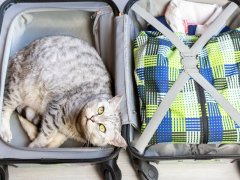






My cat has been pregnant since a bit before August 1, 2022 she is so large and irritated that I’m worried if she is past due or having a hard time going into labor. I’m so worried about my beautiful princess Misty that waddled around l8ke a fat little cow. She is a first time pregnant Persian calico mangora and possibly part minx about 4 years of age. Do I have anything to worry about. I’ve set up several different area’s for birthing and been doing all I can to keep her comfortable and she is well feed and cleaned area’s and toilet. I just don’t want my baby to suffer in anyway as well as my grandchildren in her tummy. Please let me know what you think about this situation, I will so greatly appreciate the help of information I’m sure tired of worrying
Hello April, I’m sorry it’s taken me so long to get back to you! How is Misty doing now? A cat’s gestation period is normally about 63-65 days. Sixty-five days before the 23rd of September would have been July 20th, so as long as she became pregnant later than that, you have no reason to worry about her being overdue. Again, I realize this is a bit late, but I would love to hear how everyone is doing now. Thanks for stopping by!